Abstract
The susceptibilities of 270 clinical isolates of Pseudomonas aeruginosa from diverse sources (82 burn patients, 76 cystic fibrosis [CF] patients, and 112 other sources) to ciprofloxacin and three other quinolones, nine extended-spectrum beta-lactams, and three aminoglycosides were determined by an agar dilution method in cation-supplemented Mueller-Hinton medium. Ciprofloxacin, ceftazidime, imipenem, and aztreonam were the most active. MICs for burn isolates were consistently higher than those for other isolates for most antibiotics, whereas those for CF strains were consistently lower. Multidrug resistance to aminoglycosides and beta-lactams occurred in 21% of the burn isolates, 2.6% of the CF isolates, and 8.9% of the other isolates. Ninety percent of these strains remained susceptible to ciprofloxacin. Seven percent of the isolates were resistant to ciprofloxacin (MIC, greater than or equal to 2 micrograms/ml). Concurrent resistance to ciprofloxacin and beta-lactams or aminoglycosides was rare (1.8 to 4%). Analysis by Spearman rank correlation revealed a high degree of correlation of MICs among antibiotics within the same class, except for imipenem. An inoculum effect was observed for all antibiotics between 10(6) and 10(4) CFU (P less than 0.05), with those for piperacillin and cefoperazone being the most pronounced (16-fold and 8-fold differences, respectively), and was least apparent for the quinolones, aminoglycosides, imipenem, and aztreonam (twofold differences). Selected strains for which there were high MICs of ciprofloxacin (greater than or equal to 1 micrograms/ml) were tested against ciprofloxacin in combination with other agents in a checkerboard agar dilution assay. Synergistic (summated fractional inhibitory concentration, </=0.5) interactions at clinically achievable concentrations were most frequent with mezlocillin (33%), piperacillin (21%), and (7.6%), aztreonam (3.7%), and the aminoglycosides (3.7%). Antagonism (summated fractional inhibitory concentration, >/= 4) was observed in only one instance (with gentamicin).
Full text
PDF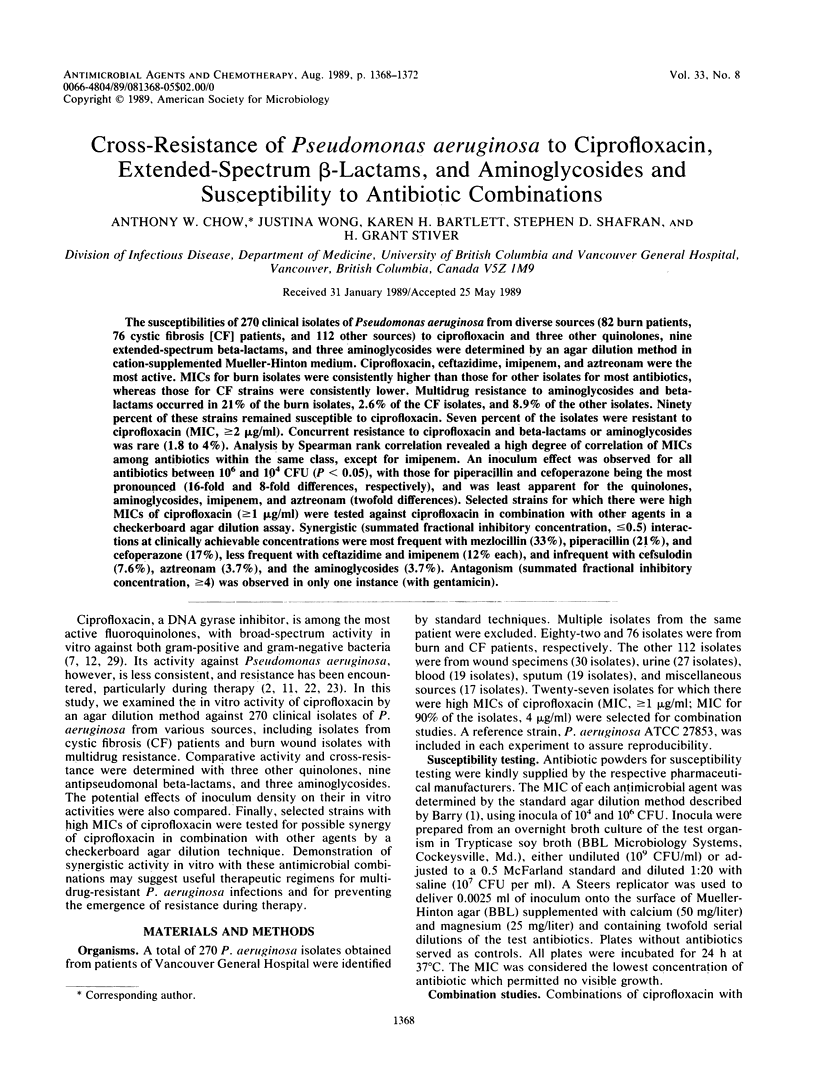
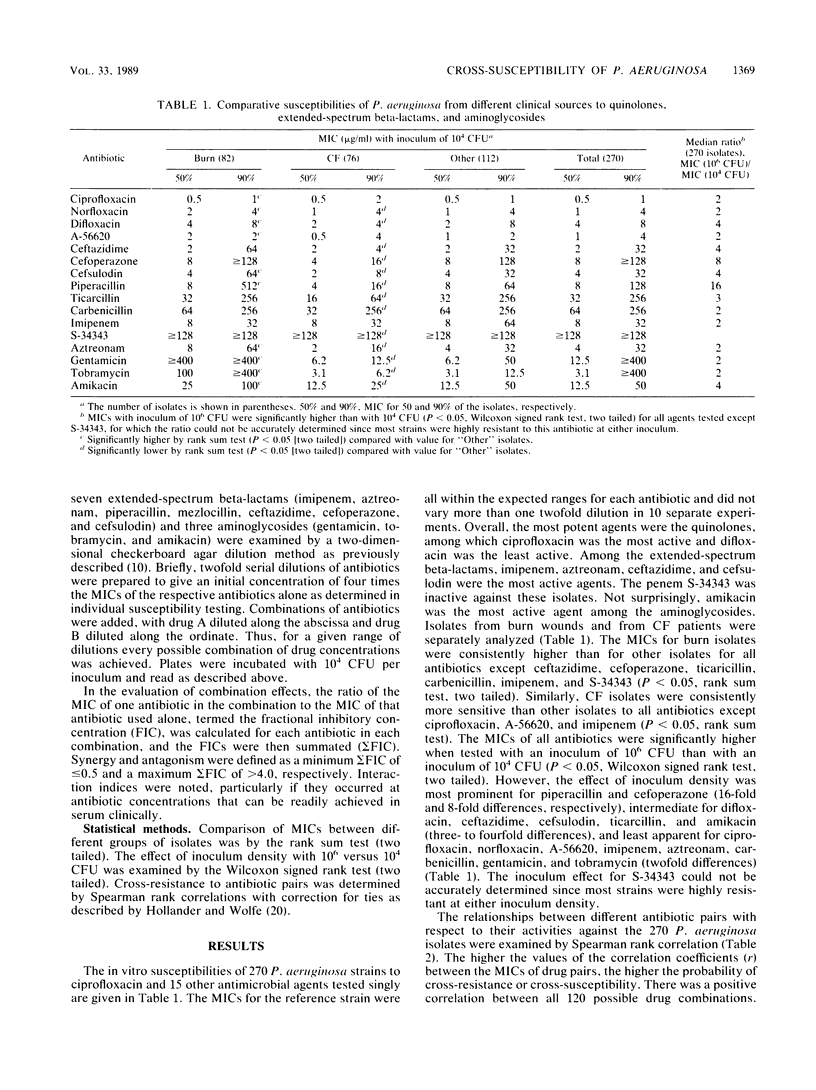
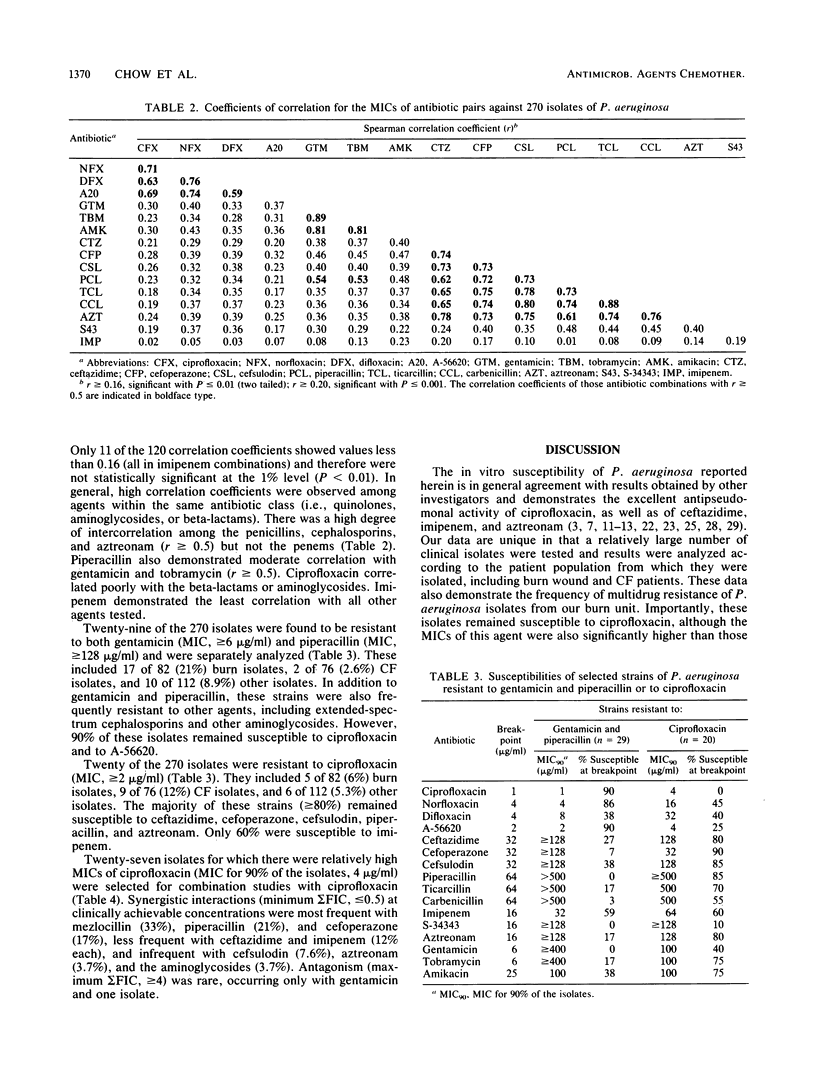
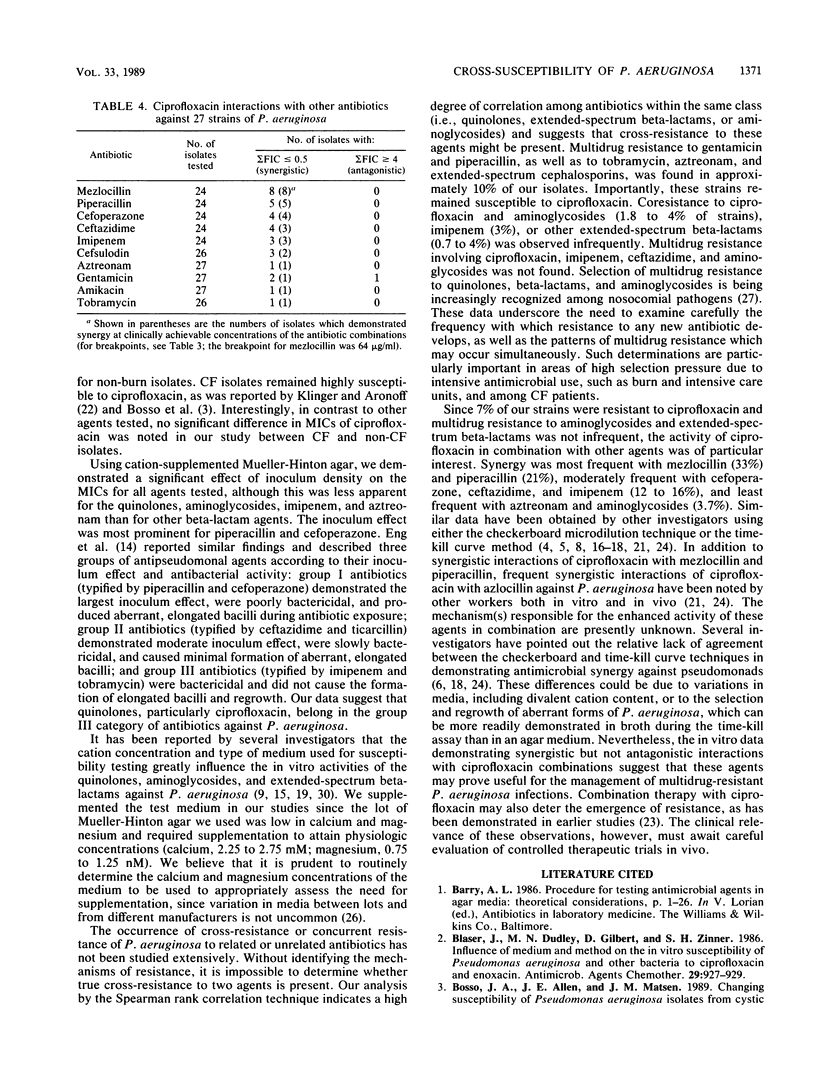
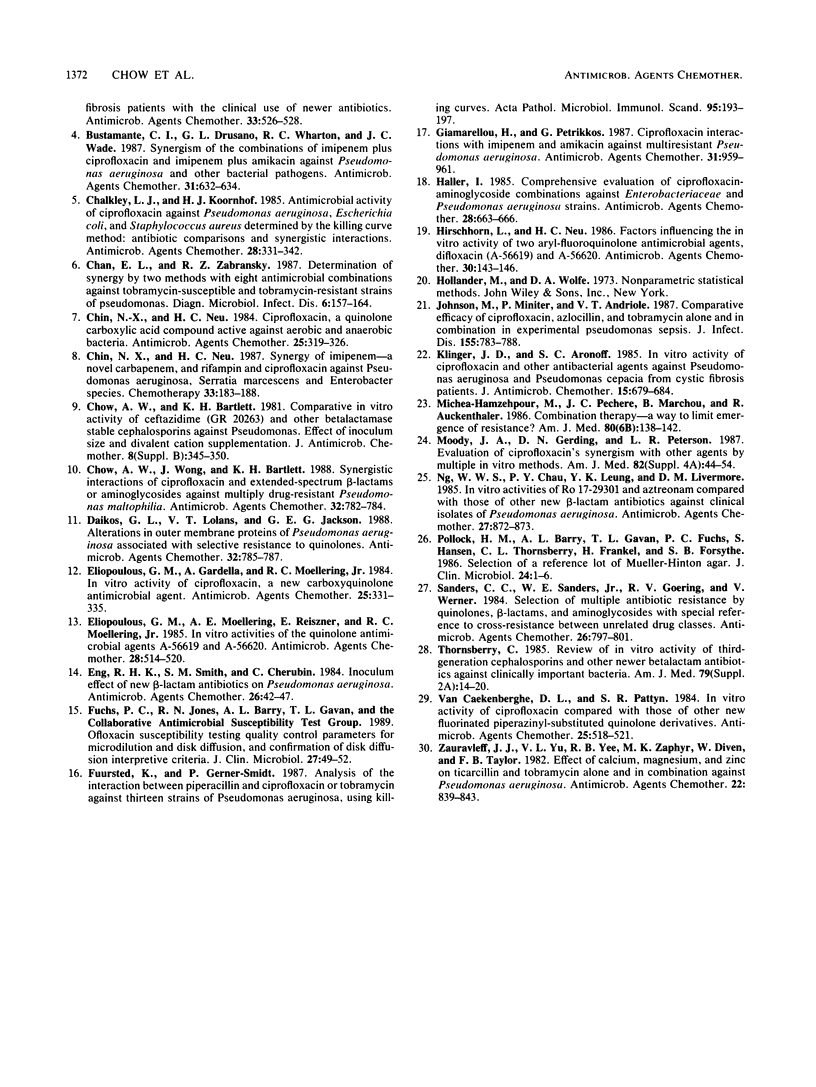
Selected References
These references are in PubMed. This may not be the complete list of references from this article.
- Blaser J., Dudley M. N., Gilbert D., Zinner S. H. Influence of medium and method on the in vitro susceptibility of Pseudomonas aeruginosa and other bacteria to ciprofloxacin and enoxacin. Antimicrob Agents Chemother. 1986 May;29(5):927–929. doi: 10.1128/aac.29.5.927. [DOI] [PMC free article] [PubMed] [Google Scholar]
- Bustamante C. I., Drusano G. L., Wharton R. C., Wade J. C. Synergism of the combinations of imipenem plus ciprofloxacin and imipenem plus amikacin against Pseudomonas aeruginosa and other bacterial pathogens. Antimicrob Agents Chemother. 1987 Apr;31(4):632–634. doi: 10.1128/aac.31.4.632. [DOI] [PMC free article] [PubMed] [Google Scholar]
- Chalkley L. J., Koornhof H. J. Antimicrobial activity of ciprofloxacin against Pseudomonas aeruginosa, Escherichia coli, and Staphylococcus aureus determined by the killing curve method: antibiotic comparisons and synergistic interactions. Antimicrob Agents Chemother. 1985 Aug;28(2):331–342. doi: 10.1128/aac.28.2.331. [DOI] [PMC free article] [PubMed] [Google Scholar]
- Chan E. L., Zabransky R. J. Determination of synergy by two methods with eight antimicrobial combinations against tobramycin-susceptible and tobramycin-resistant strains of Pseudomonas. Diagn Microbiol Infect Dis. 1987 Feb;6(2):157–164. doi: 10.1016/0732-8893(87)90101-5. [DOI] [PubMed] [Google Scholar]
- Chin N. X., Neu H. C. Ciprofloxacin, a quinolone carboxylic acid compound active against aerobic and anaerobic bacteria. Antimicrob Agents Chemother. 1984 Mar;25(3):319–326. doi: 10.1128/aac.25.3.319. [DOI] [PMC free article] [PubMed] [Google Scholar]
- Chin N. X., Neu H. C. Synergy of imipenem--a novel carbapenem, and rifampin and ciprofloxacin against Pseudomonas aeruginosa, Serratia marcescens and Enterobacter species. Chemotherapy. 1987;33(3):183–188. doi: 10.1159/000238493. [DOI] [PubMed] [Google Scholar]
- Chow A. W., Wong J., Bartlett K. H. Synergistic interactions of ciprofloxacin and extended-spectrum beta-lactams or aminoglycosides against multiply drug-resistant Pseudomonas maltophilia. Antimicrob Agents Chemother. 1988 May;32(5):782–784. doi: 10.1128/aac.32.5.782. [DOI] [PMC free article] [PubMed] [Google Scholar]
- Daikos G. L., Lolans V. T., Jackson G. G. Alterations in outer membrane proteins of Pseudomonas aeruginosa associated with selective resistance to quinolones. Antimicrob Agents Chemother. 1988 May;32(5):785–787. doi: 10.1128/aac.32.5.785. [DOI] [PMC free article] [PubMed] [Google Scholar]
- Eliopoulos G. M., Gardella A., Moellering R. C., Jr In vitro activity of ciprofloxacin, a new carboxyquinoline antimicrobial agent. Antimicrob Agents Chemother. 1984 Mar;25(3):331–335. doi: 10.1128/aac.25.3.331. [DOI] [PMC free article] [PubMed] [Google Scholar]
- Eliopoulos G. M., Moellering A. E., Reiszner E., Moellering R. C., Jr In vitro activities of the quinolone antimicrobial agents A-56619 and A-56620. Antimicrob Agents Chemother. 1985 Oct;28(4):514–520. doi: 10.1128/aac.28.4.514. [DOI] [PMC free article] [PubMed] [Google Scholar]
- Eng R. H., Smith S. M., Cherubin C. Inoculum effect of new beta-lactam antibiotics on Pseudomonas aeruginosa. Antimicrob Agents Chemother. 1984 Jul;26(1):42–47. doi: 10.1128/aac.26.1.42. [DOI] [PMC free article] [PubMed] [Google Scholar]
- Fuchs P. C., Jones R. N., Barry A. L., Gavan T. L. Ofloxacin susceptibility testing quality control parameters for microdilution and disk diffusion, and confirmation of disk diffusion interpretive criteria. J Clin Microbiol. 1989 Jan;27(1):49–52. doi: 10.1128/jcm.27.1.49-52.1989. [DOI] [PMC free article] [PubMed] [Google Scholar]
- Fuursted K., Gerner-Smidt P. Analysis of the interaction between piperacillin and ciprofloxacin or tobramycin against thirteen strains of Pseudomonas aeruginosa, using killing curves. Acta Pathol Microbiol Immunol Scand B. 1987 Jun;95(3):193–197. doi: 10.1111/j.1699-0463.1987.tb03111.x. [DOI] [PubMed] [Google Scholar]
- Giamarellou H., Petrikkos G. Ciprofloxacin interactions with imipenem and amikacin against multiresistant Pseudomonas aeruginosa. Antimicrob Agents Chemother. 1987 Jun;31(6):959–961. doi: 10.1128/aac.31.6.959. [DOI] [PMC free article] [PubMed] [Google Scholar]
- Haller I. Comprehensive evaluation of ciprofloxacin-aminoglycoside combinations against Enterobacteriaceae and Pseudomonas aeruginosa strains. Antimicrob Agents Chemother. 1985 Nov;28(5):663–666. doi: 10.1128/aac.28.5.663. [DOI] [PMC free article] [PubMed] [Google Scholar]
- Hirschhorn L., Neu H. C. Factors influencing the in vitro activity of two new aryl-fluoroquinolone antimicrobial agents, difloxacin (A-56619) and A-56620. Antimicrob Agents Chemother. 1986 Jul;30(1):143–146. doi: 10.1128/aac.30.1.143. [DOI] [PMC free article] [PubMed] [Google Scholar]
- Johnson M., Miniter P., Andriole V. T. Comparative efficacy of ciprofloxacin, azlocillin, and tobramycin alone and in combination in experimental Pseudomonas sepsis. J Infect Dis. 1987 Apr;155(4):783–788. doi: 10.1093/infdis/155.4.783. [DOI] [PubMed] [Google Scholar]
- Klinger J. D., Aronoff S. C. In-vitro activity of ciprofloxacin and other antibacterial agents against Pseudomonas aeruginosa and Pseudomonas cepacia from cystic fibrosis patients. J Antimicrob Chemother. 1985 Jun;15(6):679–684. doi: 10.1093/jac/15.6.679. [DOI] [PubMed] [Google Scholar]
- Michéa-Hamzehpour M., Pechère J. C., Marchou B., Auckenthaler R. Combination therapy: a way to limit emergence of resistance? Am J Med. 1986 Jun 30;80(6B):138–142. doi: 10.1016/0002-9343(86)90491-2. [DOI] [PubMed] [Google Scholar]
- Moody J. A., Gerding D. N., Peterson L. R. Evaluation of ciprofloxacin's synergism with other agents by multiple in vitro methods. Am J Med. 1987 Apr 27;82(4A):44–54. [PubMed] [Google Scholar]
- Ng W. W., Chau P. Y., Leung Y. K., Livermore D. M. In vitro activities of Ro 17-2301 and aztreonam compared with those of other new beta-lactam antibiotics against clinical isolates of Pseudomonas aeruginosa. Antimicrob Agents Chemother. 1985 May;27(5):872–873. doi: 10.1128/aac.27.5.872. [DOI] [PMC free article] [PubMed] [Google Scholar]
- Pollock H. M., Barry A. L., Gavan T. L., Fuchs P. C., Hansen S., Thornsberry C. L., Frankel H., Forsythe S. B. Selection of a reference lot of Mueller-Hinton agar. J Clin Microbiol. 1986 Jul;24(1):1–6. doi: 10.1128/jcm.24.1.1-6.1986. [DOI] [PMC free article] [PubMed] [Google Scholar]
- Sahn S. A., Good J. T., Jr, Reller L. B. Cephradine concentrations in serum, pleural fluid, pleura, and lung of normal rabbits. J Antimicrob Chemother. 1981 Oct;8(4):345–346. doi: 10.1093/jac/8.4.345. [DOI] [PubMed] [Google Scholar]
- Sanders C. C., Sanders W. E., Jr, Goering R. V., Werner V. Selection of multiple antibiotic resistance by quinolones, beta-lactams, and aminoglycosides with special reference to cross-resistance between unrelated drug classes. Antimicrob Agents Chemother. 1984 Dec;26(6):797–801. doi: 10.1128/aac.26.6.797. [DOI] [PMC free article] [PubMed] [Google Scholar]
- Thornsberry C. Review of in vitro activity of third-generation cephalosporins and other newer beta-lactam antibiotics against clinically important bacteria. Am J Med. 1985 Aug 9;79(2A):14–20. doi: 10.1016/0002-9343(85)90255-4. [DOI] [PubMed] [Google Scholar]
- Van Caekenberghe D. L., Pattyn S. R. In vitro activity of ciprofloxacin compared with those of other new fluorinated piperazinyl-substituted quinoline derivatives. Antimicrob Agents Chemother. 1984 Apr;25(4):518–521. doi: 10.1128/aac.25.4.518. [DOI] [PMC free article] [PubMed] [Google Scholar]
- Zuravleff J. J., Yu V. L., Yee R. B., Zaphyr M. K., Diven W., Taylor F. B. Effect of calcium, magnesium, and zinc on ticarcillin and tobramycin alone and in combination against Pseudomonas aeruginosa. Antimicrob Agents Chemother. 1982 Nov;22(5):839–843. doi: 10.1128/aac.22.5.839. [DOI] [PMC free article] [PubMed] [Google Scholar]


